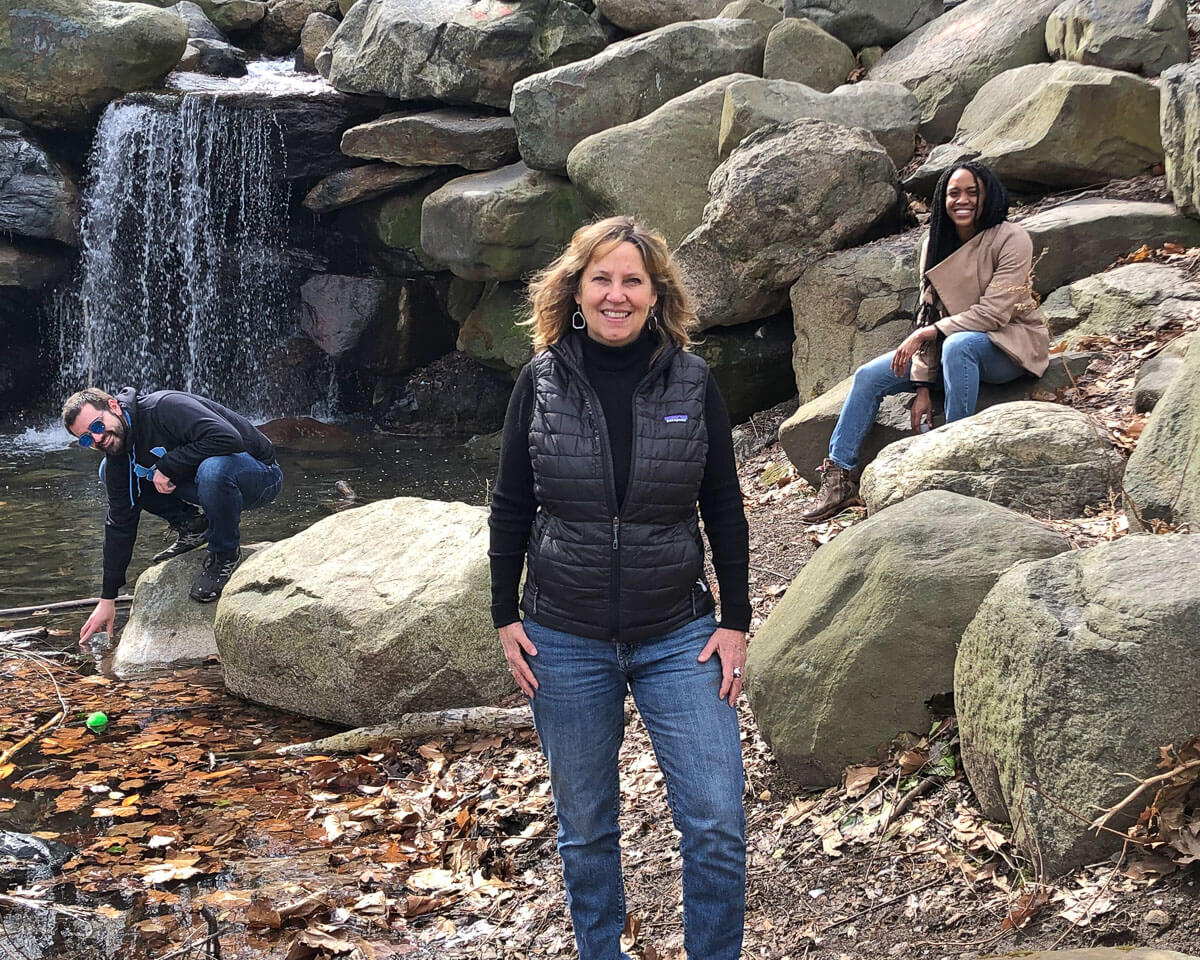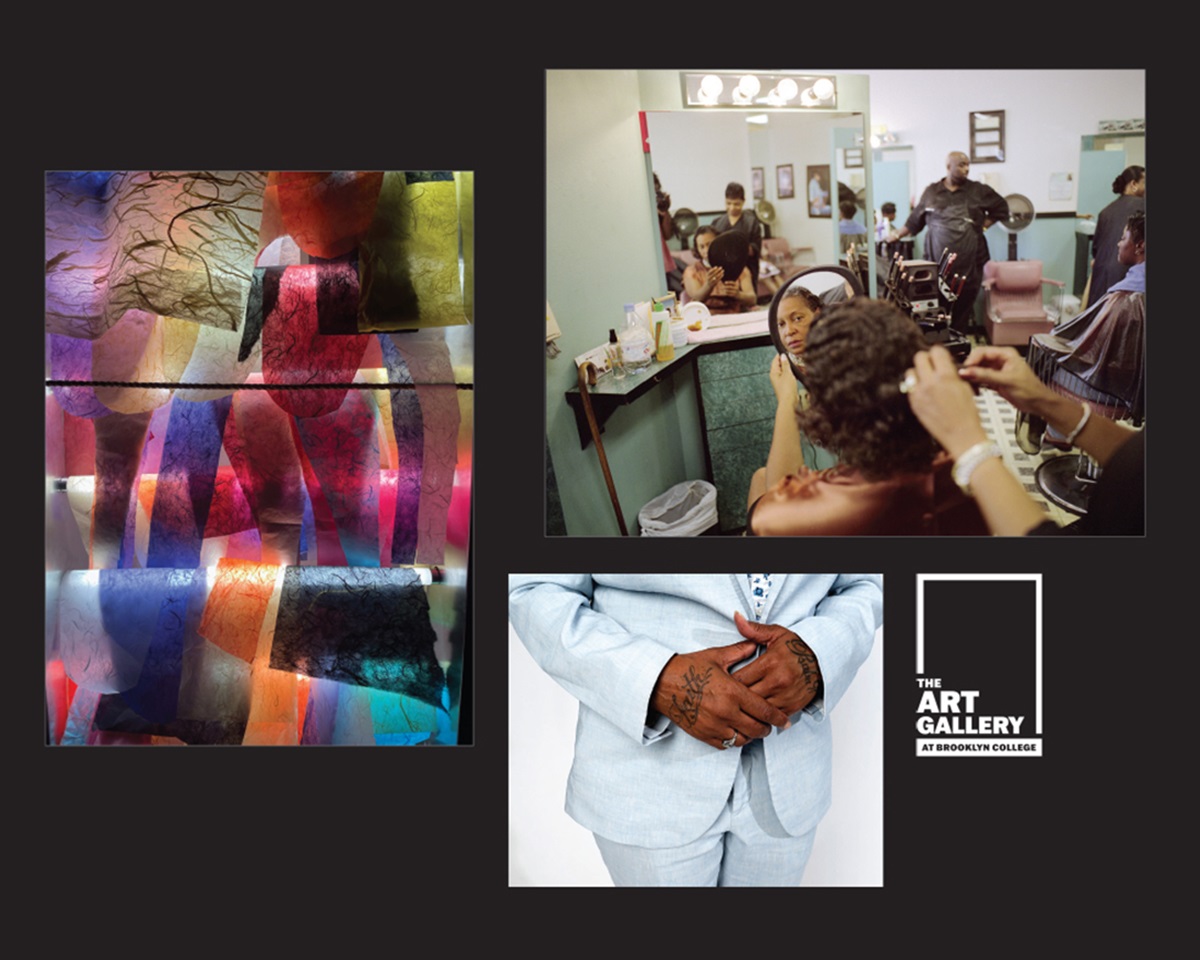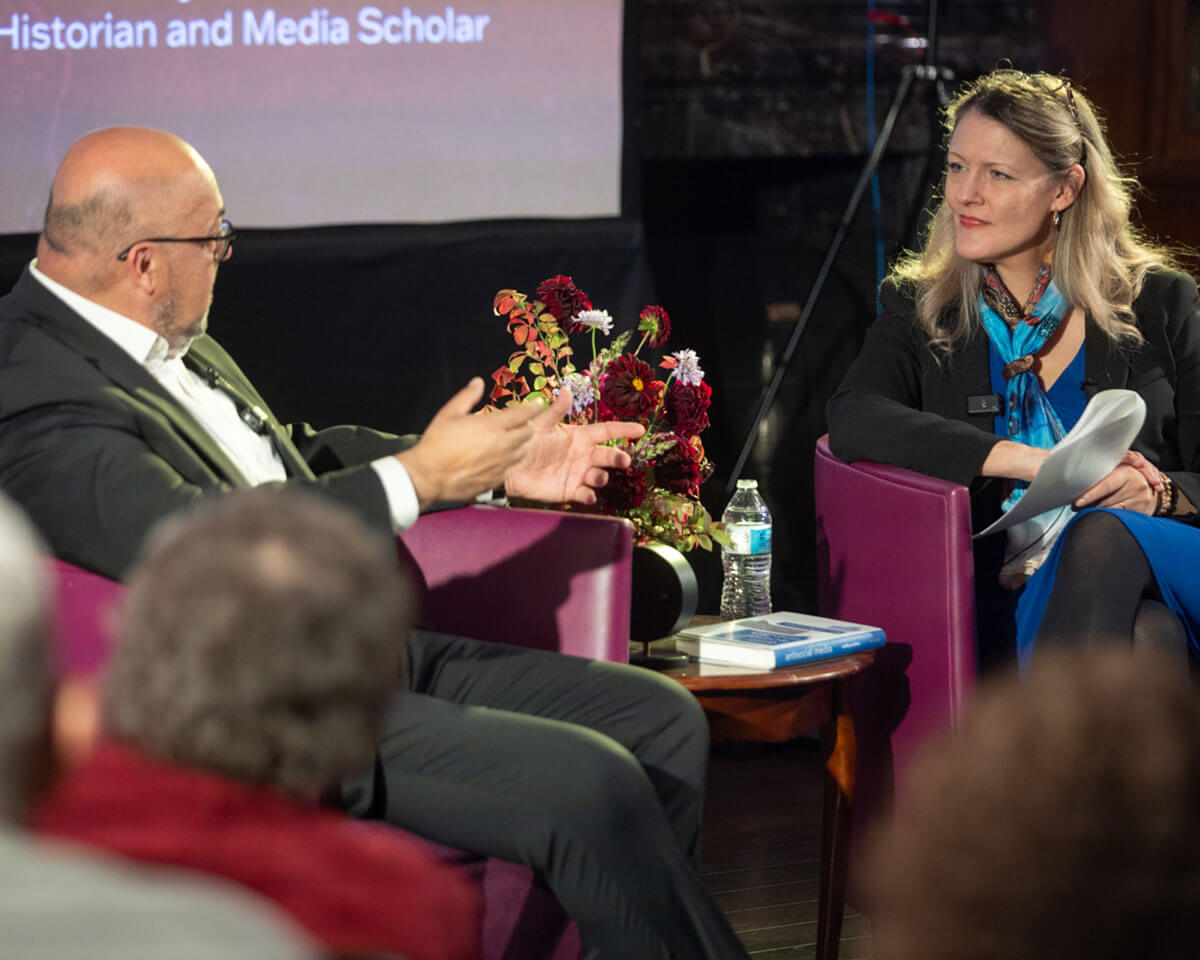Spring has sprung, and that means getting outside. And for many Brooklynites, Prospect Park has served as the perfect destination for decades.
But there has been a cloud of sorts over its 55-acre lake in the form of toxic blue-green algae blooms. Not to be confused with the large amounts of duckweed—a small flowering plant that often coats the lake—the toxic blue-green algae, or cyanobacteria, which appears as a green paint slick in the water, is harmful to people, pets, and wildlife.
It has also proven to be nearly impossible to control.
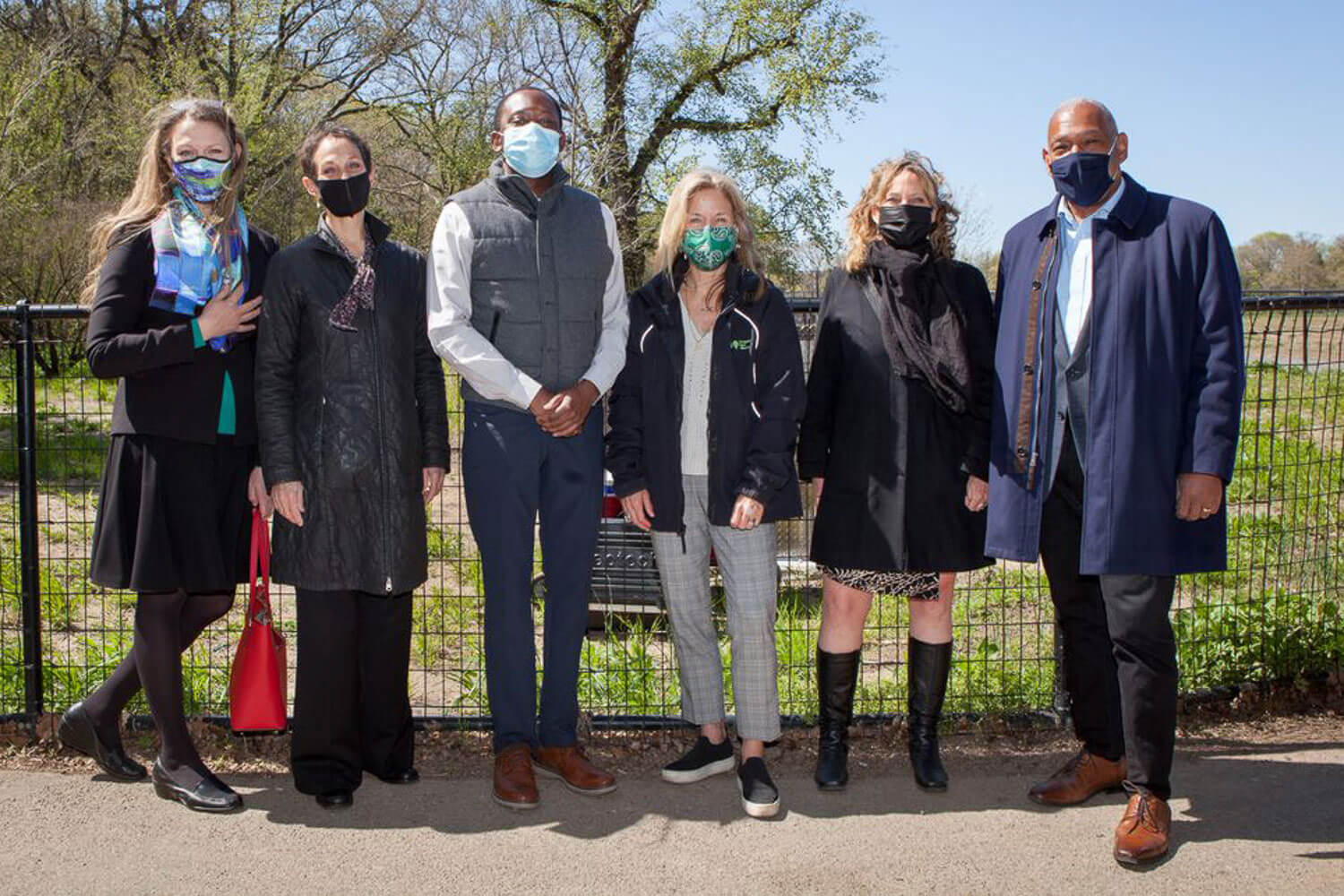
(L-R) Brooklyn College President Michelle J. Anderson; Leslie Wright, New York City Regional Director, New York State Parks; Dante Arwine, District Manager, Community Board 9; Sue Donoghue, President, Prospect Park Alliance; Jennifer Cherrier, ecoWEIR inventor and Brooklyn College professor and chair of the Department of Earth and Environmental Sciences; and Mitchell J. Silver, New York City Parks Commissioner, stand in front of the site of one ecoWEIR system near Dog Beach at Prospect Park during its public unveiling on April 23.
But thanks to an invention by professor and chair of Brooklyn College’s Department of Earth and Environmental Sciences Jennifer Cherrier, a solution that gets to the root of the problem is having a positive impact.
Cherrier, who studies aquatic biogeochemistry and water resource sustainability, says the problem at Prospect Park and urban lakes in other cities is phosphorus. Because New York City has an abundance of old buildings with lead piping, phosphorus has been added to drinking water supplies since the early 1990s to help remove it. This same water supply is used for the city’s urban lakes, so the added phosphate also serves as a nutrient that fuels toxic algae growth. To combat the phosphorus, Cherrier invented what can be described as an “underground Brita filter system” that uses nature to remove the phosphate and other pollutants. The system is called ecoWEIR, and Prospect Park is the first public park in the nation to utilize its water-washing power.
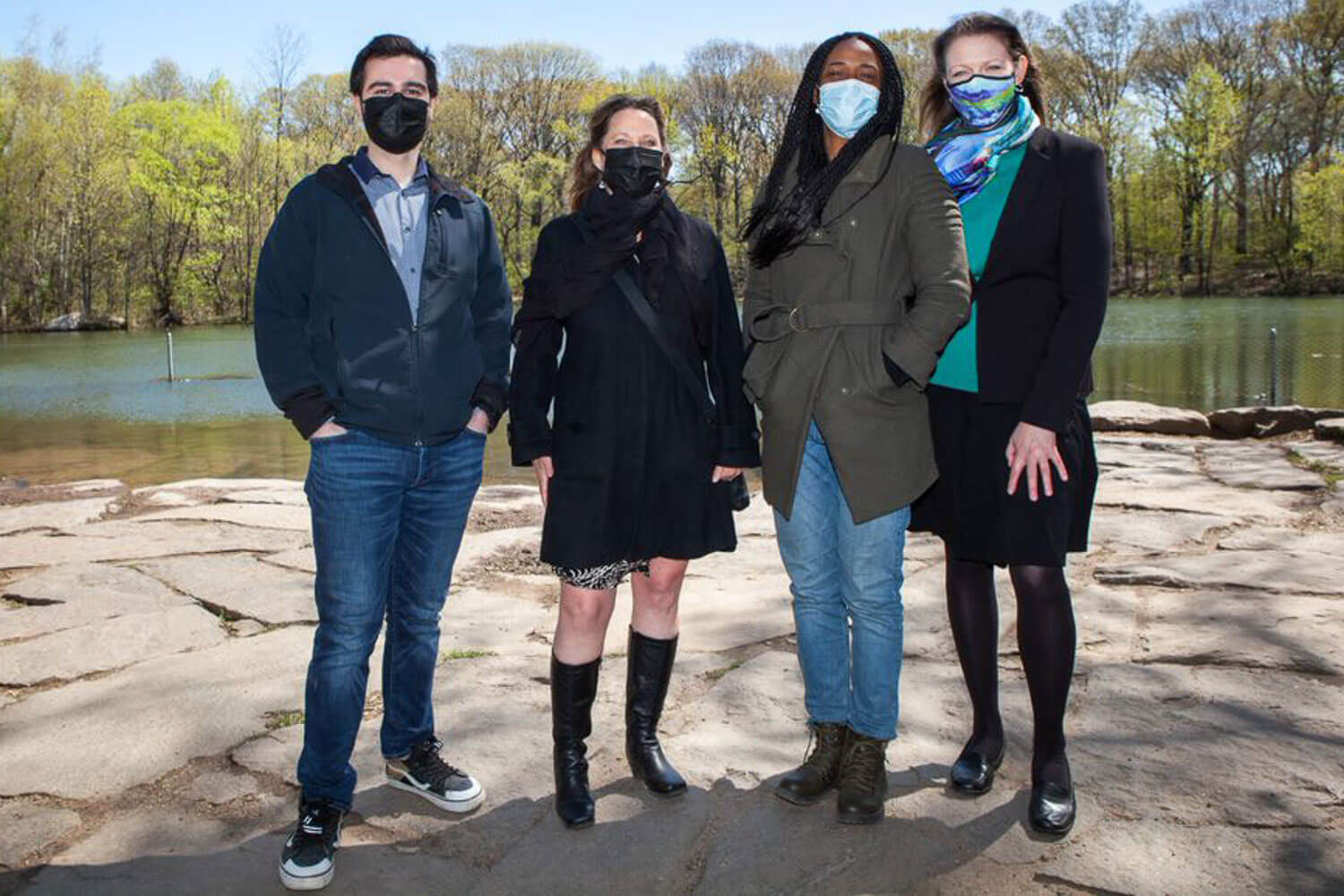
Reese LeVea, Jennifer Cherrier, Nia René, and Brooklyn College President Michelle J. Anderson at the April 23 launch event.
The two pilot ecoWEIR systems are located near the baseball and softball fields. Each comprises a large, sealed 600-square-foot underground vault with a patented “smart-sensored” pipe and valve system at its base. These smart sensors allow for the monitoring of the system performance in real time as well as the actuating of the ecoWEIR valve system that is automated and controlled remotely. Overlaid with gravel, sand, and soil, the system is topped off with either grass or native plants. Using gravity, water from what is known as the upper or “Fallkill” waterfall is directed underground toward the two systems. There, the water sits one foot below the soil’s surface, just below the plants’ roots, creating a shallow “aquifer” system where phosphorus and other nutrients can be treated by being absorbed naturally by the soil bacteria and plants. Once treated, the clean water is then released back into the watercourse after 24 hours.
Cherrier says the Prospect Park project’s roots go back to 2015, when she came to Brooklyn College and met with the Prospect Park Alliance’s vice president of capital & landscape management, Christian Zimmerman.
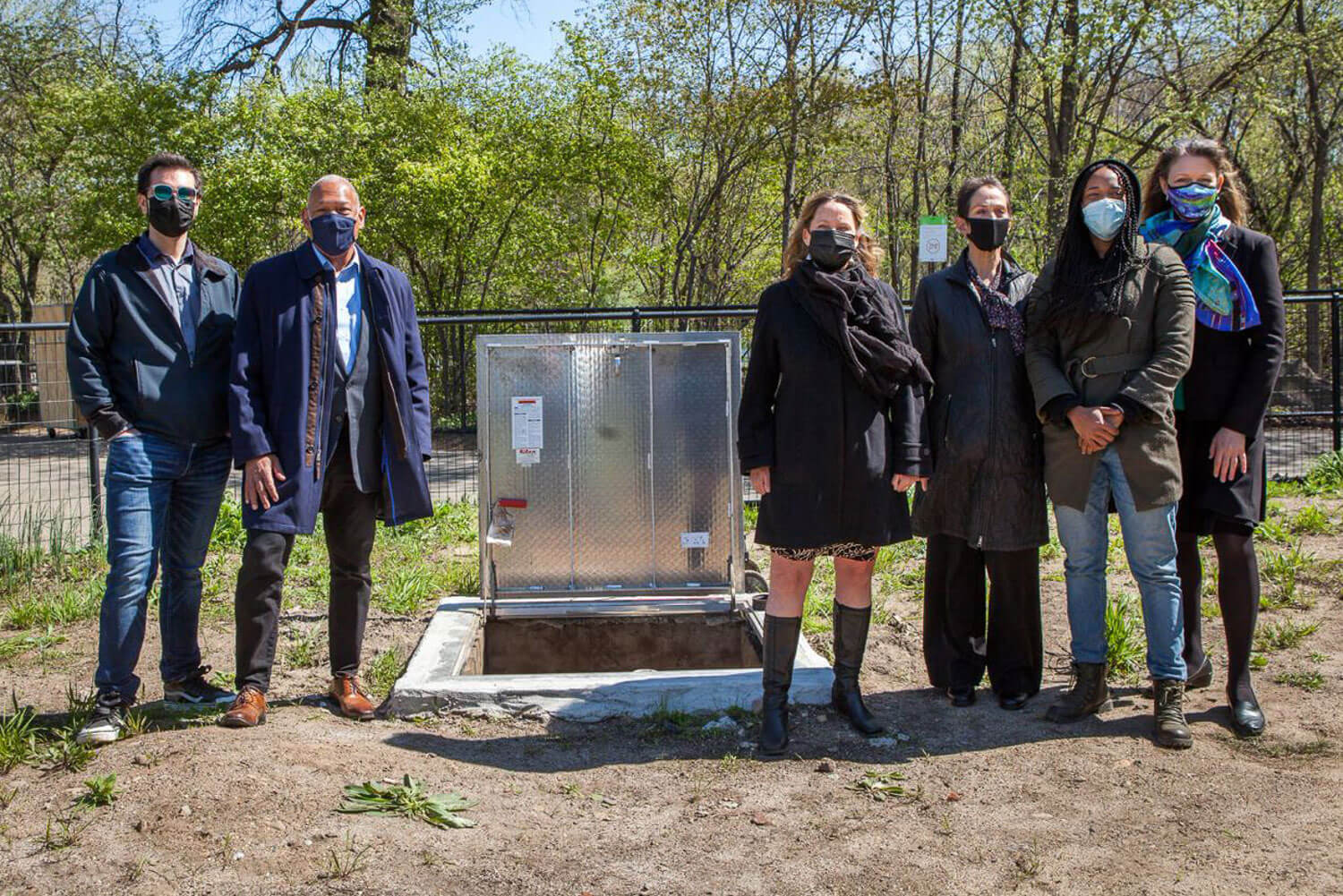
Reese LeVea ’19, with J. Mitchell Silver, New York City Parks Commissioner; Brooklyn College Professor and ecoWEIR inventor Jennifer Cherrier; Leslie Wright, New York City Regional Director, New York State Parks; alumna Nia René; and Michelle J. Anderson, president of Brooklyn College.
“A colleague at Brooklyn College, Associate Professor Brett Branco, who is also an expert in urban environmental science, knew about my ecoWEIR system and the work I had been doing with the National Oceanic and Atmospheric Administration to offset harmful algal blooms. Brett thought ecoWEIR would be a good fit for Prospect Park to address the problem,” says Cherrier. “Christian was interested right away, and we set out to find funding, which we were thrilled to receive in a grant from the New York State Office of Parks, Recreation and Historic Preservation.”
Zimmerman says the partnership has been productive and the system is having positive results.
“The Prospect Park Alliance is very excited about the possibilities of Professor Cherrier’s ecoWEIR system for reducing phosphates in our water course,” says Zimmerman. “It has already shown to be successful, and I could see Prospect Park installing a larger system in the future that could reduce even more algae and duckweed.”
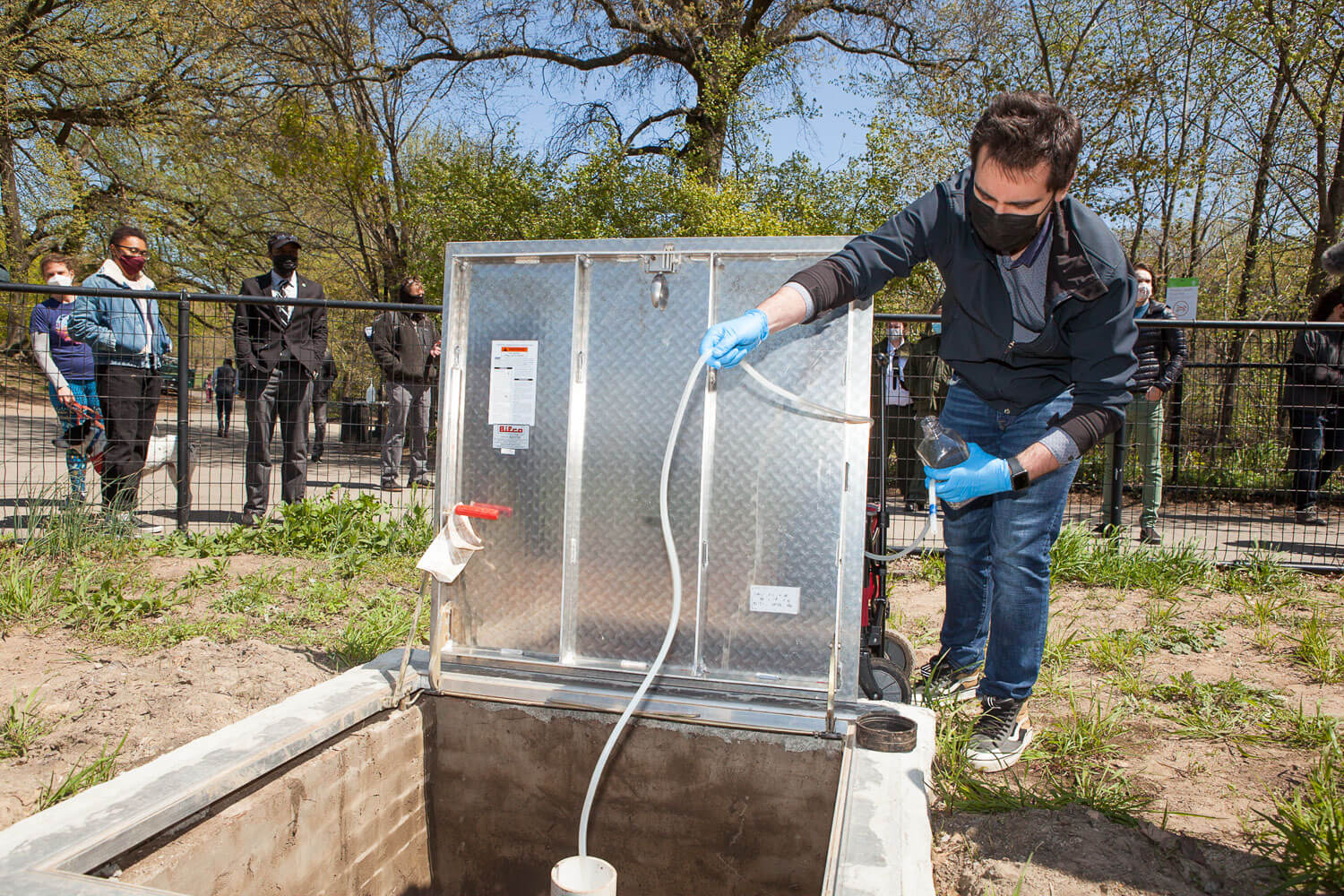
Reese LeVea ’19 gives a demonstration on ecoWEIR at its launch event on April 23 in Prospect Park.
Much of the work on ecoWEIR was done at Brooklyn College in the aquatic research lab atop Ingersoll Hall Extension. Students who have gone through or are currently in the earth and environmental sciences program have helped Cherrier with the ecoWEIR project, including Reese LeVea, Nia René, and Ewa Poncyliusz.
René earned her master’s degree from Brooklyn College in 2019 and chronicled ecoWEIR technology for her thesis paper. A NOAA CREST (National Oceanic and Atmospheric Administration-Cooperative REmote Sensing Science & Technology) Fellow, she is now teaching the lab portion of the Introduction to Earth Science course at the college while pursuing her Ph.D. at the CUNY Graduate Center, where Cherrier serves as her adviser. René will research harmful algal blooms on the Prospect Park project.
“I became interested in ecoWEIR after meeting Jennifer and learning more about her work. I have always been interested in reducing aquatic pollution and ecoWEIR applies to so many aspects of this. I believe it can help solve a lot of problems related to algae blooms and even coastal flooding,” René says.
Reese LeVea started working on water samples and analysis from the park’s Lake Prospect at the end of March. He earned his undergraduate degree in 2019 and is currently working toward his master’s degree. Already accepted by the University of New Hampshire’s Ph.D. program, he is another student Cherrier has mentored and brought onto this project.
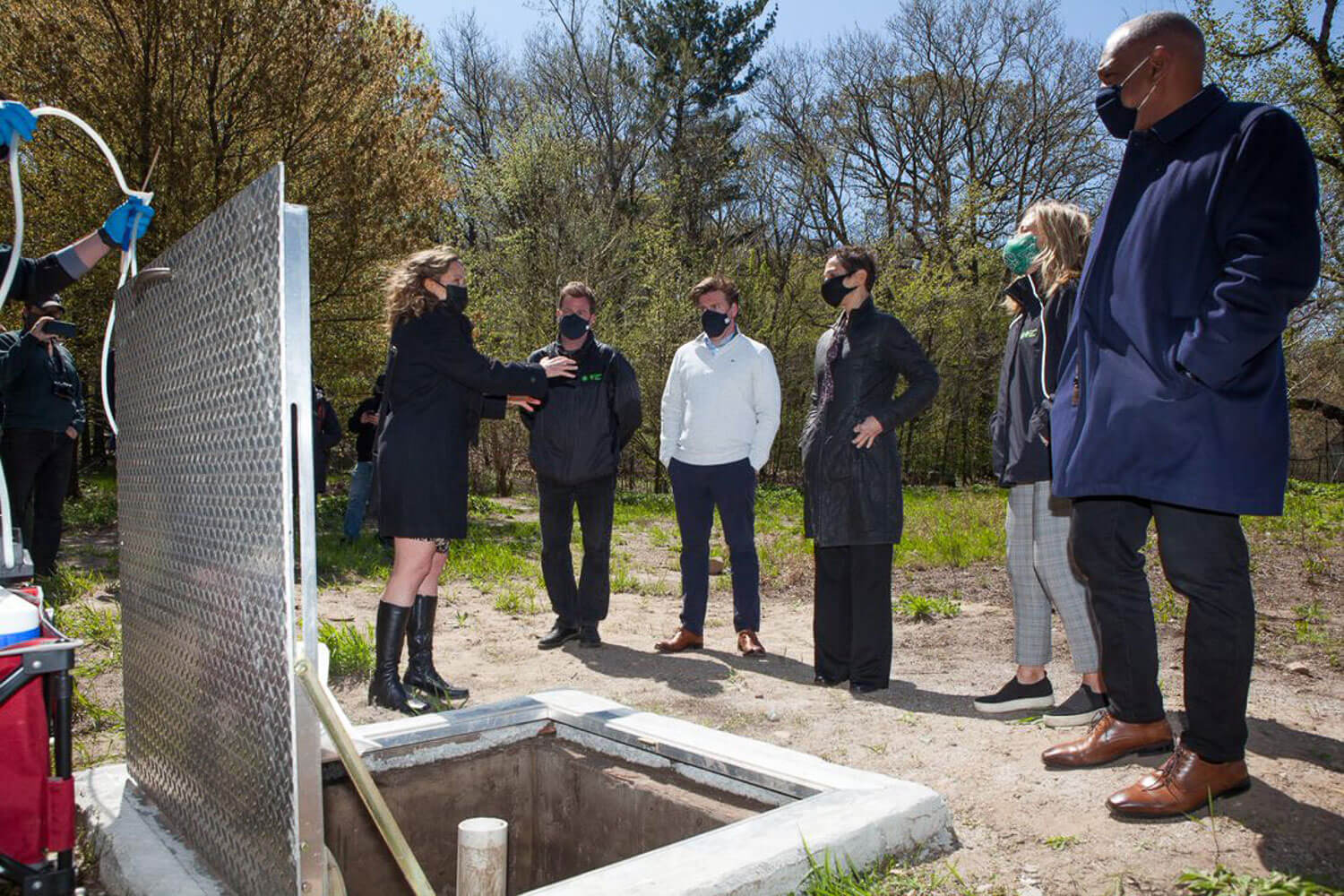
Professor Jennifer Cherrier (left) explains how her ecoWEIR system works as Christian Zimmerman, Prospect Park Alliance’s Vice President of Capital & Landscape Management; Robert Carroll, New York State Assembly Member; Leslie Wright, New York City Regional Director; Sue Donoghue, President, Prospect Park Alliance; and Mitchell J. Silver, New York City Parks Commissioner look on.
Ewa Poncyliusz is another Brooklyn College graduate student studying earth and environmental science. She is doing work with the Prospect Park Alliance for its educational outreach to help spread the word about ecoWEIR and harmful algae blooms.
So far, the system has proven to be a win-win; it uses a completely green infrastructure to remove stormwater-related pollutants and allow for water storage and reuse at the same time. Cherrier and her research team will monitor the pilot ecoWEIR in Prospect Park throughout the spring and summer. If the study shows a reduction in harmful algae blooms, the Prospect Park system could become a model for other parks in the city and beyond.
Cherrier, who initially studied oceanography, is also testing ecoWEIR on Long Island to clean septic discharges. She is working with the New York City Department of Environmental Protection, local nonprofit groups, and the private sector to find ways to use ecoWEIR and other nature-based approaches to mitigate local stormwater flooding and coastal pollution. For example, when it rains in New York City, stormwater and wastewater are released directly into our waterways via combined sewer overflows. As the city looks for ways to intercept stormwater from roads and other impervious surfaces to keep it from entering sewers, nature-based approaches like ecoWEIR could be a huge help.
Closer to home, Cherrier and her team are planning an experimental ecoWEIR installation near the Brooklyn College Library.
“It’s going to take a lot of tools in the toolbox to address urban water challenges,” says Cherrier. “EcoWEIR tech is one of the tools that I’m hoping people will choose. It’s less expensive, it delivers reliable and consistent results, and it’s nature-based. Nature knows how to clean itself; we just need to give it an ecoWEIR boost with the proper conditions to get the work done. This collaborative study between Brooklyn College and Prospect Park is an important step for getting this technology into New York City’s toolbox.”
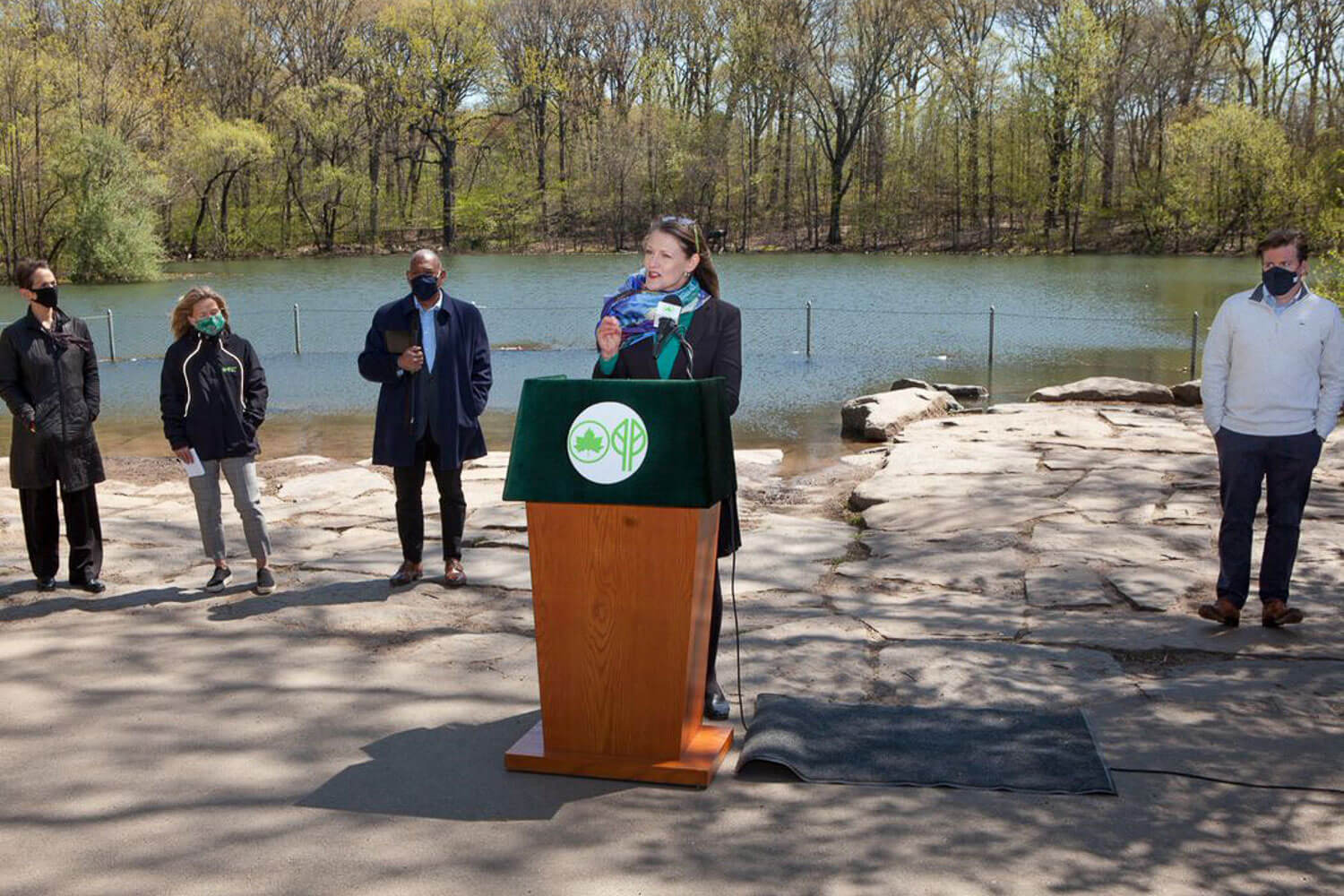
President Michelle J. Anderson addresses the crowd at the April 23 launch of Professor Jennifer Cherrier’s ecoWEIR system that is being used on a pilot project to clean toxic algae from Prospect Park’s water. From left to right are Leslie Wright, New York City Regional Director; Sue Donoghue, President, Prospect Park Alliance; Mitchell J. Silver, New York City Parks Commissioner; and Robert Carroll, New York State Assembly Member.
Return to the BC Magazine

